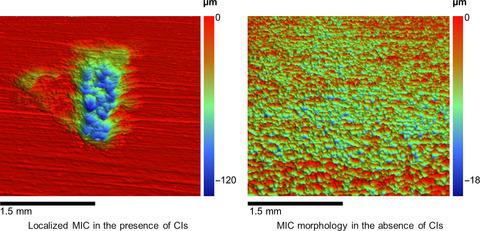当前位置:
X-MOL 学术
›
Microb. Biotechnol.
›
论文详情
Our official English website, www.x-mol.net, welcomes your feedback! (Note: you will need to create a separate account there.)
Oil field microorganisms cause highly localized corrosion on chemically inhibited carbon steel
Microbial Biotechnology ( IF 5.7 ) Pub Date : 2020-09-17 , DOI: 10.1111/1751-7915.13644 Jaspreet Mand 1 , Dennis Enning 1
Microbial Biotechnology ( IF 5.7 ) Pub Date : 2020-09-17 , DOI: 10.1111/1751-7915.13644 Jaspreet Mand 1 , Dennis Enning 1
Affiliation

|
Carbon steel pipelines, a means for crude oil transportation, occasionally experience highly localized perforation caused by microorganisms. While microorganisms grown in laboratory culture tend to corrode steel specimens unevenly, they rarely inflict a corrosion morphology consistent with that of pipelines, where centimetre‐sized corrosion features are randomly distributed within vast stretches of otherwise pristine metal surface. In this study, we observed that corrosion inhibitors (CIs), widely used for the control of acid gas (H2S, CO2) corrosion in oil fields, also affect microbial growth and activity. Inhibited carbon steel resisted biofilm formation and underwent negligible corrosion (< 0.002 mm Fe0 year−1), despite 15 months of exposure to oil field waters harbouring a diverse microbiome. In contrast, physical scavenging of CI in these waters led to severe and highly localized corrosion (up to 0.93 mm Fe0 year−1) underneath biofilms dominated by methanogenic archaea and sulfate‐reducing bacteria. A sharp decline in CI concentration, as well as its active components, quaternary ammonium compounds (QACs), correlated with microbial sulfidogenesis. CIs are ubiquitously present in oil field waters and play an underappreciated role in microbial corrosion mitigation. Physical and biological scavenging of CIs may create local differences in steel inhibition effectiveness and thus result in highly localized corrosion.
中文翻译:

油田微生物对化学抑制碳钢造成高度局部腐蚀
碳钢管道是原油运输的一种方式,偶尔会遇到由微生物引起的局部穿孔。尽管实验室培养中生长的微生物倾向于腐蚀钢试样,但它们很少产生与管道一致的腐蚀形态,在这种原始金属表面上,厘米大小的腐蚀特征随机分布在广阔的伸展带中。在这项研究中,我们观察到腐蚀抑制剂(CIs),广泛用于控制油田中的酸性气体(H 2 S,CO 2)腐蚀,也影响微生物的生长和活性。抑制碳钢抵抗生物膜形成和后行腐蚀可忽略(<0.002毫米的Fe 0一年-1),尽管暴露于藏有多种微生物的油田水域中已有15个月。相反,对这些水中的CI进行物理清除会导致由产甲烷的古生菌和还原硫酸盐的细菌主导的生物被膜下的严重且高度局部化的腐蚀(Fe 0 year -1高达0.93 mm )。CI浓度及其活性成分季铵化合物(QAC)的急剧下降与微生物硫化作用有关。CIs普遍存在于油田水域中,并且在缓解微生物腐蚀方面起着不被重视的作用。CI的物理和生物清除可能会在钢抑制效果方面造成局部差异,从而导致高度局部腐蚀。
更新日期:2020-09-17
中文翻译:

油田微生物对化学抑制碳钢造成高度局部腐蚀
碳钢管道是原油运输的一种方式,偶尔会遇到由微生物引起的局部穿孔。尽管实验室培养中生长的微生物倾向于腐蚀钢试样,但它们很少产生与管道一致的腐蚀形态,在这种原始金属表面上,厘米大小的腐蚀特征随机分布在广阔的伸展带中。在这项研究中,我们观察到腐蚀抑制剂(CIs),广泛用于控制油田中的酸性气体(H 2 S,CO 2)腐蚀,也影响微生物的生长和活性。抑制碳钢抵抗生物膜形成和后行腐蚀可忽略(<0.002毫米的Fe 0一年-1),尽管暴露于藏有多种微生物的油田水域中已有15个月。相反,对这些水中的CI进行物理清除会导致由产甲烷的古生菌和还原硫酸盐的细菌主导的生物被膜下的严重且高度局部化的腐蚀(Fe 0 year -1高达0.93 mm )。CI浓度及其活性成分季铵化合物(QAC)的急剧下降与微生物硫化作用有关。CIs普遍存在于油田水域中,并且在缓解微生物腐蚀方面起着不被重视的作用。CI的物理和生物清除可能会在钢抑制效果方面造成局部差异,从而导致高度局部腐蚀。



























 京公网安备 11010802027423号
京公网安备 11010802027423号